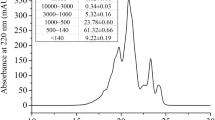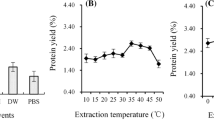Abstract
Corn gluten meal (CGM) was hydrolyzed by Alcalase 2.4L and Protex 7L to obtain low-molecular-weight peptides. The antioxidant and angiotensin-I-converting enzyme (ACE) inhibitory activities of the peptides were determined by 2,2′-Azinobis-(3-ethylbenzthiazoline-6-sulphonate) (ABTS) free radical scavenging activity, the JHH7 cell oxidative stress model, and the ACE inhibition assay, respectively. Corn peptides (CPs) had strong antioxidant capacity to scavenge ABTS radicals (1.44 ± 0.11 mmol/g), and significantly reduced reactive oxygen species and malondialdehyde levels in oxidized JHH7 cells, increasing superoxide dismutase, catalase, and glutathione peroxidase activities by 26.20%, 147.52%, and 43.20%, respectively, at the concentration of 800 μg/mL. CPs had high ACE inhibitory activity, with an IC50 value of 0.27 ± 0.05 mg/mL. Next, the CPs were separated by reverse-phase high-performance liquid chromatography. Twelve fractions were collected, and their ABTS free radical scavenging and ACE inhibitory activities were determined. Fractions 1, 2, 3, 4, and 9 showed higher ABTS free radical scavenging and ACE inhibitory activities. Twelve peptides were identified from active fractions by liquid chromatography–tandem mass spectrometry (LC–MS/MS) as Leu-Ser-Pro-Tyr, Leu-Asn-Ser-Pro-Ala-Tyr, Tyr-Gly-Pro-Gln, Pro-Pro-Tyr, Ala-Tyr-Pro-Glu, Thr-Tyr-Ser-Gly-Pro-Lys, Ala-Tyr-Pro-Gly-Pro-Gln, Leu-Ala-Tyr-Pro-Gln, Ala-Tyr-Leu-Gln-Gln-Gln, Ser-Ala-Pro, Asn-Ala-Pro, and Val-Asn-Ala-Pro. These peptides exhibited good ABTS free radical scavenging and ACE inhibitory activities. Therefore, CPs may have potential applications in the food industry as functional material additives.




Similar content being viewed by others
References
Sarmadi BH, Ismail A (2010) Antioxidative peptides from food proteins: a review. Peptides 31(10):1949–1956
Gu RZ, Liu WY, Lin F, Jin ZT, Chen L, Yi WX, Lu J, Cai MY (2012) Antioxidant and angiotensin I-converting enzyme inhibitory properties of oligopeptides derived from black-bone silky fowl (Gallus gallus domesticus Brisson) muscle. Food Res Int 49(1):326–333
She X, Wang F, Ma J, Chen X, Ren D, Lu Y (2016) In vitro antioxidant and protective effects of corn peptides on ethanol-induced damage in HepG2 cells. Food Agric Immunol 27(1):99–110
Hwang JY, Shyu YS, Wang YT, Hsu CK (2010) Antioxidative properties of protein hydrolysate from defatted peanut kernels treated with esperase. LWT-Food Sci Technol 43(2):285–290
Revilla E, Maria CS, Miramontes E, Bautista J, Garcia-Martinez A, Cremades O, Cert R, Parrado J (2009) Nutraceutical composition, antioxidant activity and hypocholesterolemic effect of a water-soluble enzymatic extract from rice bran. Food Res Int 42(3):387–393
Chakrabarti S, Liao W, Davidge ST, Wu J (2017) Milk-derived tripeptides IPP (Ile-Pro-Pro) and VPP (Val-Pro-Pro) differentially modulate angiotensin II effects on vascular smooth muscle cells. J Funct Foods 30:151–158
Liao W, Chakrabarti S, Davidge ST, Wu J (2016) Modulatory effects of egg white ovotransferrin-derived tripeptide IRW (Ile-Arg-Trp) on vascular smooth muscle cells against angiotensin II stimulation. J Agric Food Chem 64(39):7342–7347
Wu J, Liao W, Udenigwe CC (2017) Revisiting the mechanisms of ACE inhibitory peptides from food proteins. Trends Food Sci Tech 69(6):214–219
Zhuang H, Tang N, Yuan Y (2013) Purification and identification of antioxidant peptides from corn gluten meal. J Funct Foods 5(4):1810–1821
Zhou C, Hu J, Ma H, Yagoub EGA, Yu X, Qwusu J, Ma H, Qin X (2015) Antioxidant peptides from corn gluten meal: orthogonal design evaluation. Food Chem 187:270–278
Wang L, Ding L, Yu Z, Zhang T, Ma S, Liu J (2016) Intracellular ROS scavenging and antioxidant enzyme regulating capacities of corn gluten meal-derived antioxidant peptides in HepG2 cells. Food Res Int 90:33–41
AOAC. Association of Official Analytical Chemists, Washington DC
Lin F, Chen L, Liang R, Zhang Z, Wang J, Cai M, Li Y (2011) Pilot-scale production of low molecular weight peptides from corn wet milling byproducts and the antihypertensive effects in vivo and in vitro. Food Chem 124(3):801–807
Yang Y, Tao G, Liu P, Liu J (2007) Peptide with angiotensin I-converting enzyme inhibitory activity from hydrolyzed corn gluten meal. J Agric Food Chem 55(19):7891–7895
Tironi VA, Anon MC (2010) Amaranth proteins as a source of antioxidant peptides: effect of proteolysis. Food Res Int 43(1):315–322
Żyżelewicz D, Zakłos-Szyda M, Juśkiewicz J, Bojczuk M, Oracz J, Budryn G, Miśkiewicz K, Krysiak W, Zduńczyk Z, Jurgoński A (2016) Cocoa bean (Theobroma cacao L.) phenolic extracts as PTP1B inhibitors, hepatic HepG2 and pancreatic β-TC3 cell cytoprotective agents and their influence on oxidative stress in rats. Food Res Int 89(2):946–957
Wang J, Hu J, Cui J, Bai X, Du Y, Miyaguchi Y, Lin B (2008) Purification and identification of a ACE inhibitory peptide from oyster proteins hydrolysate and the antihypertensive effect of hydrolysate in spontaneously hypertensive rats. Food Chem 111(2):302–308
Liu WY, Lu J, Gao F, Gu RZ, Lin F, Ren DF, Cai MY (2015) Preparation, characterization and identification of calcium-chelating Atlantic salmon (Salmo salar L.) ossein oligopeptides. Eur Food Res Technol 241(6):851–860
Rajapakse N, Mendis E, Jung WK, Je JY, Kim SK (2005) Purification of a radical scavenging peptide from fermented mussel sauce and its antioxidant properties. Food Res Int 38(2):175–182
You L, Zhao M, Regenstein JM, Ren J (2010) Purification and identification of antiox-idative peptides from loach (Misgurnus anguillicaudatus) protein hydrolysate by consecutive chromatography and electrospray ionization–mass spectrometry. Food Res Int 43(4):1167–1173
Fang H, Luo M, Sheng Y, Li ZX, Wu YQ, Liu C (2008) The antihypertensive effect of peptides: a novel alternative to drugs. Peptides 29(6):1062–1071
Cheung HS, Wang FL, Ondetti MA, Sabo EF, Cushman DW (1980) Binding of peptide substrates and inhibitors of angiotensin-converting enzyme—importance of the COOH-terminal dipeptide sequence. J Biol Chem 255(2):401–407
Gómez-Ruiz JA, Ramos M, Recio I (2007) Identification of novel angiotensin converting enzyme-inhibitory peptides from ovine milk proteins by CE-MS and chromatographic techniques. Electrophoresis 28(22):4202–4211
Li Q, Liao W, Fan H, Wu J (2018) Optimization and scale-up preparation of egg white hydrolysate with angiotensin I converting enzyme inhibitory activity. J Food Sci 83(6):1762–1768
Yarnpakdee S, Benjakul S, Kristinsson HG, Bakken HE (2015) Preventive effect of Nile tilapia hydrolysate against oxidative damage of HepG2 cells and DNA mediated By H2O2 and AAPH. J Food Sci Technol 52(10):6194–6205
Wiriyaphan C, Chitsomboon B, Roytrakul S, Yongsawadigul J (2013) Isolation and identification of antioxidative peptides from hydrolysate of threadfin bream surimi processing byproduct. J Funct Foods 5(4):1654–1664
Katayama S, Ishikawa S, Fan MZ, Mine Y (2007) Oligophosphopeptides derived from egg yolk phosvitin up-regulate gamma-glutamylcysteine synthetase and antioxidant enzymes against oxidative stress in caco-2 cells. J Agric Food Chem 55(8):2829–2835
Kensler TW, Wakabayash N, Biswal S (2007) Cell survival responses to environmental stresses via the Keap1-Nrf2-ARE pathway. Annu Rev Pharmacol Toxicol 47(1):89–116
Segura Campos MR, Chel Guerrero LA, Betancur Ancona DA (2010) Angiotensin-I converting enzyme inhibitory and antioxidant activities of peptide fractions extracted by ultrafiltration of cowpea Vigna unguiculata hydrolysates. J Sci Food Agr 90(14):2512–2518
Maebuchi M, Samoto M, Kohno M (2007) Improvement in the intestinal absorption of soy protein by enzymatic digestion to oligopeptide in healthy adult me. Food Sci Technol Res 13(1):45–53
Wang L, Ding L, Wang Y, Zhang Y, Liu J (2015) Isolation and characterisation of in vitro and cellular free radical scavenging peptides from corn peptide fractions. Molecules 20(2):3221–3237
Terashima M, Baba T, Ikemoto N, Katayama M, Morimoto T, Matsumura S (2010) Novel angiotensin-converting enzyme (ACE) inhibitory peptides derived from boneless chicken leg meat. J Agric Food Chem 58(12):7432–7436
van Platerink CJ, Janssen HM, Haverkamp J (2008) Application of at-line two-dimensional liquid chromatography–mass spectrometry for identification of small hydrophilic angiotensin I-inhibiting peptides in milk hydrolysates. Anal Bioanal Chem Res 391(1):299–307
Mane S, Jamdar S (2016) Purification and identification of ACE-inhibitory peptides from poultry viscera protein hydrolysate. J Food Biochem 41(2):1–10
Saiga A, Tanabe S, Nishimura T (2003) Antioxidant activity of peptides obtained from porcine myofibrillar proteins by protease treatment. J Agric Food Chem 51(12):3661–3667
Wang XJ, Zheng XQ, Kopparapu NK, Cong WS, Deng YP, Sun XJ, Liu XL (2014) Purification and evaluation of a novel antioxidant peptide from corn protein hydrolysate. Process Biochem 49(9):1562–1569
Tang X, He Z, Dai Y, Xiong YL, Xie M, Chen J (2010) Peptide fractionation and free radical scavenging activity of zein hydrolysate. J Agric Food Chem 58(1):587–593
Ma Y, Xiong YL, Zhai J, Zhu H, Dziubla T (2010) Fractionation and evaluation of radical scavenging peptides from in vitro digests of buckwheat protein. Food Chem 118(3):582–588
Alemán A, Giménez B, Pérez-Santin E, Gómez-Guillén MC, Montero P (2011) Contribution of Leu and Hyp residues to antioxidant and ACE-inhibitory activities of peptide sequences isolated from squid gelatin hydrolysate. Food Chem 125(2):334–341
Siow HL, Gan CY (2013) Extraction of antioxidative and antihypertensive bioactive peptides from Parkia speciosa seeds. Food Chem 141(4):3435–3442
Lapsongphon N, Yongsawatdigul J (2013) Production and purification of antioxidant peptides from a mungbean meal hydrolysate by Virgibacillus sp. SK37 proteinase. Food Chem 141(2):992–999
Ryan JT, Ross RP, Bolton D, Fitzgerald GF, Stanton C (2011) Bioactive peptides from muscle sources: meat and fish. Nutrients 3(9):765–791
Gu RZ, Li CY, Liu WY, Yi WX, Cai MY (2012) Angiotensin I-converting enzyme inhibitory activity of low-molecular-weight peptides from Atlantic salmon (Salmo salar L.) skin. Food Res Int 44(5):1536–1540
Zheng Y, Li Y, Li G (2019) ACE-inhibitory and antioxidant peptides from coconut cake albumin hydrolysates: purification, identification and synthesis. Rsc Adv 9(11):5925–5936
Acknowledgements
This study was supported by grants from the National Key Research and Development Program of China (No. 2016YFD0400604), the General Program of the National Natural Science Foundation of China (No. 31671963), and Fund by Key Laboratory of Animal Protein Food Deep Processing Technology of Zhejiang Province (ZJAP-2019–01).
Author information
Authors and Affiliations
Corresponding author
Ethics declarations
Conflict of interest
The authors declare no conflict of interest.
Compliance with ethics requirements
This article does not contain any studies with human or animal subjects.
Additional information
Publisher's Note
Springer Nature remains neutral with regard to jurisdictional claims in published maps and institutional affiliations.
Rights and permissions
About this article
Cite this article
Liu, WY., Fang, L., Feng, XW. et al. In vitro antioxidant and angiotensin I-converting enzyme inhibitory properties of peptides derived from corn gluten meal. Eur Food Res Technol 246, 2017–2027 (2020). https://doi.org/10.1007/s00217-020-03552-6
Received:
Revised:
Accepted:
Published:
Issue Date:
DOI: https://doi.org/10.1007/s00217-020-03552-6




